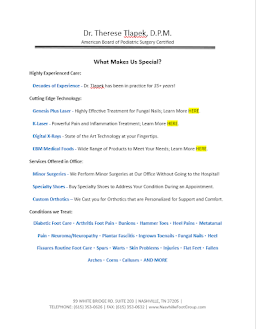Immediate Treatment
Foot and ankle emergencies happen every day. Broken bones, dislocations, sprains, contusions, infections, and other serious injuries can occur at any time. Early attention is vitally important. Whenever you sustain a foot or ankle injury, you should seek immediate treatment from a podiatric physician.
This advice is universal, even though there are lots of myths about foot and ankle injuries. Some of them follow:
Myths
- "It can't be broken, because I can move it." False; this widespread idea has kept many fractures from receiving proper treatment. The truth is that often you can walk with certain kinds of fractures. Some common examples: Breaks in the smaller, outer bone of the lower leg, small chip fractures of either the foot or ankle bones, and the often neglected fracture of the toe.
- "If you break a toe, immediate care isn't necessary." False; a toe fracture needs prompt attention. If X-rays reveal it to be a simple, displaced fracture, care by your podiatric physician usually can produce rapid relief. However, X-rays might identify a displaced or angulated break. In such cases, prompt realignment of the fracture by your podiatric physician will help prevent improper or incomplete healing. Often, fractures do not show up in the initial X-ray. It may be necessary to X-ray the foot a second time, seven to ten days later. Many patients develop post-fracture deformity of a toe, which in turn results in a deformed toe with a painful corn. A good general rule is: Seek prompt treatment for injury to foot bones.
- "If you have a foot or ankle injury, soak it in hot water immediately." False; don’t use heat or hot water on an area suspect for fracture, sprain, or dislocation. Heat promotes blood flow, causing greater swelling. More swelling means greater pressure on the nerves, which causes more pain. An ice bag wrapped in a towel has a contracting effect on blood vessels, produces a numbing sensation, and prevents swelling and pain. Your podiatric physician may make additional recommendations upon examination.
- "Applying an elastic bandage to a severely sprained ankle is adequate treatment." False; ankle sprains often mean torn or severely overstretched ligaments, and they should receive immediate care. X-ray examination, immobilization by casting or splinting, and physiotherapy to ensure a normal recovery all may be indicated. Surgery may even be necessary.
- "The terms 'fracture,' 'break,' and 'crack' are all different." False; all of those words are proper in describing a broken bone.
Before Seeing the Podiatrist
If an injury or accident does occur, the steps you can take to help yourself until you can reach your podiatric physician are easy to remember if you can recall the word “rice.”
- Rest. Restrict your activity and get off your foot/ankle.
- Ice. Gently place a plastic bag of ice wrapped in a towel on the injured area in a 20-minute-on, 40-minute-off cycle.
- Compression. Lightly wrap an Ace bandage around the area, taking care not to pull it too tight.
- Elevation. To reduce swelling and pain, sit in a position that allows you to elevate the foot/ankle higher than your waist.
- For bleeding cuts, cleanse well, apply pressure with gauze or a towel, and cover with a clean dressing. See your podiatrist as soon as possible. It’s best not to use any medication on the cut before you see the doctor.
- Leave blisters unopened if they are not painful or in a weight-bearing area of the foot. A compression bandage placed over a blister can provide relief.
- Foreign materials in the skin—such as slivers, splinters, and sand—can be removed carefully, but a deep foreign object, such as broken glass or a needle, must be removed professionally.
- Treatment for an abrasion is similar to that of a burn, since raw skin is exposed to the air and can easily become infected. It is important to remove all foreign particles with thorough cleaning. Sterile bandages should be applied, along with an antibiotic cream or ointment.
Prevention
- Wear the correct shoes for your particular activity.
- Wear hiking shoes or boots in rough terrain.
- Don't continue to wear any sports shoe if it is worn unevenly.
- The toe box in “steel-toe” shoes should be deep enough to accommodate your toes comfortably.
- Always wear hard-top shoes when operating a lawn mower or other grass-cutting equipment.
- Don’t walk barefoot on paved streets or sidewalks.
- Watch out for slippery floors at home and at work. Clean up obviously dangerous spills immediately.
- If you get up during the night, turn on a light. Many fractured toes and other foot injuries occur while attempting to find one’s way in the dark.
Make an appointment
With our seven locations across Middle Tennessee, Nashville Foot and Ankle Group has an office near you.
Call your nearest Nashville podiatrist today and a member of our courteous and smiling staff will be happy to assist you.












